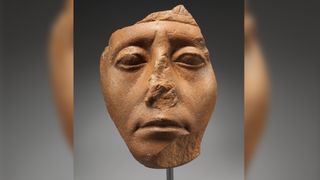
Why Are the Noses Broken on So Many Ancient Egyptian Statues?

The ancient Egyptians were artistic champions, carving countless statues that showcased the society's pharaohs, religious figures and wealthy citizens. But though these statues depicted different people or beings, many of them share a commonality: broken noses.
This broken nose epidemic is so pervasive, it makes you wonder whether these busted sniffers were the result of haphazard accidents or whether something more sinister was afoot.
It turns out, the answer is, in most cases, the latter.
These statues have broken noses because many ancient Egyptians believed that statues had a life force. And if an opposing power came across a statue it wanted to disable, the best way to do that was to break off the statue's nose, said Adela Oppenheim, a curator in the Department of Egyptian Art at The Metropolitan Museum of Art in New York City. [How Were the Egyptian Pyramids Built?]
Granted, the ancient Egyptians didn't actually think that statues, even with their life force, could get up and move around, given that they were made out of stone, metal or wood. Nor did the Egyptians think that the statues were literally breathing. "They knew that they weren't inhaling air — they could see that," Oppenheim told Live Science. "On the other hand, the statues have a life force, and the life force comes through the nose, that's how you breathe."
It was common to perform ceremonies on statues, including the "opening of the mouth ritual," in which the statue was anointed with oils and had different objects held up to it, which were believed to enliven it, Oppenheim said.
"This ritual gave the statue a kind of life and power," Oppenheim said.
Sign up for the Live Science daily newsletter now
Get the world’s most fascinating discoveries delivered straight to your inbox.
The belief that statues had a life force was so widespread that it spurred antagonists to extinguish that force when the need arose. For example, people taking apart, repurposing, robbing or desecrating temples, tombs and other sacred sites would have likely believed that statues had life forces that could in some way harm intruders. People would even believe this about hieroglyphs or other images of animals or people.
"You basically have to kill it," and one way to do that was to cut off the nose of the statue or image, so that it couldn't breathe, Oppenheim said.
However, sometimes adversaries didn't stop at just the nose. Some also smashed or damaged the face, arms and legs to deactivate the life force, Oppenheim said.
There are likely some instances in which statues naturally tipped over, and a protruding nose broke as a result. Erosion from the elements, such as wind and rain, also likely wore down some statues' noses. But you can usually tell if a nose was destroyed intentionally by looking at cut marks on the statue, Oppenheim said.
For people looking to learn more, there's an exhibit at the Pulitzer Arts Foundation in St. Louis that explores how both pharaohs and early Christians vandalized Egyptian statues so that they could "kill" any life force within the representations. The exhibit, organized in collaboration with the Brooklyn Museum, runs through Aug. 11, 2019.
- How Egyptian Pharaohs Rose to Power
- How Does Egypt's Government Work?
- Photos: Ancient Egyptian Statues of Deities Found in Pit
Originally published on Live Science.

Laura is the archaeology and Life's Little Mysteries editor at Live Science. She also reports on general science, including paleontology. Her work has appeared in The New York Times, Scholastic, Popular Science and Spectrum, a site on autism research. She has won multiple awards from the Society of Professional Journalists and the Washington Newspaper Publishers Association for her reporting at a weekly newspaper near Seattle. Laura holds a bachelor's degree in English literature and psychology from Washington University in St. Louis and a master's degree in science writing from NYU.
Most Popular


